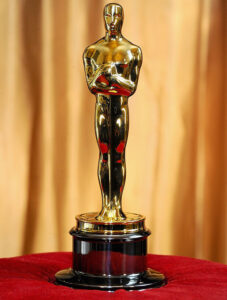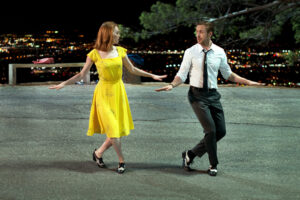Tag: Blaine Payer ’18
Lana is New, Not Necessarily Improved
by thecowl.ae on April 27, 2017
Arts & Entertainment

By Blaine Payer `18
A&E Staff
Lana Del Rey used to be queen of somber, melodic music, but the 31 year-old pop-rock star seems to have turned a page in her career.
On April 11, the singer-songwriter released the cover for her fourth album, Lust for Life, which s displays with a full-mouth smile, marking a huge departure from her previous, more serious album covers.
Critics and fans alike are not used to this new side of Del Rey. While some find it optimistic and refreshing, others are worried that such a dramatic shift will betray who she is as an artist. With two bright new singles, a cheery new album cover, and a late May album release date set, it seems like Lana Del Rey is looking to make 2017 the happiest year of her life.
Del Rey released “Love,” her first single since her very successful third album, Honeymoon, on Feb. 11. It received overwhelming praise from critics, with Pitchfork placing it at number one on their Best New Track list for the week. Thematically, it is one of her most positive songs (not written about California), celebrating the experience of love that everyone should have at least once in their lives.
Seeing as how she has written two albums and an EP about the same ex-boyfriend who spent years hurting her, it is surprising that she is now choosing to see the positive sides of love. Saying that things don’t matter because “it’s enough to be young and in love,” is a stark contrast from her earlier songs like “Ultraviolence,” in which her crooning voice announces to the listener that “He hit me and it felt like true love.”
Her new positive outlook spills over onto the album cover, which shows her jovially leaning against a 1950s pickup truck, dressed from head to toe in flower child garb, just in time for Coachella. The first time listeners saw Del Rey, she was somberly staring down the camera on the cover of her freshman album Born to Die.
Even the titles suggest a wholehearted shift away from the sadness and pain that made everyone fall in love with her back in 2011. Her new bright smile and peaceful attire seem to say that she has moved on from her dark past and is ready to embrace a bright future.
In an interview with The Dapifer, Del Rey opened up about how the politics of the past year completely changed the original direction of the album, which she wanted to have a ’50s-’60s vibe. “As the climate kept on getting more heated politically, I found lyrically everything was just directed towards that.”
She follows by stating her desire to speak to her younger audience, who need happiness and optimism now more than ever. Her newest single, “Lust for Life,” which she recorded with The Weeknd, showcases the very carefree joy that she desires, with a chorus revolving around going to the top of the Hollywood sign and taking all of your clothes off.
So far, this new, happier Del Rey is being met with nothing but warmth and praise. However, for someone who has made an entire career out of being sad and vengeful, this thematic change spells uncertainty for the future. Will anything of hers ever match the solemn desperation of Born to Die? Is Del Rey finally ready to leave the past behind, and if so, where will she go from here?
Fleet Foxes Back After Six-Year Hiatus
by The Cowl Editor on April 6, 2017
Arts & Entertainment

by Blaine Payer ’18
A&E Staff
After six years of silence following their 2011 Grammy-nominated album, Helplessness Blues, the indie-folk band Fleet Foxes has ended their hiatus. The group is expected to begin touring in May, coinciding with the release of their highly anticipated third album, Crack-Up. With a new single released in early March and an ever-growing list of upcoming tour dates, the future of the Fleet Foxes has not only come out from the shadows, but it looks brighter than ever.
Front man and principle songwriter Robin Pecknold had been teasing both his own solo work as well as various mysterious recording sessions on Instagram for months, never offering fans any concrete information on the future of the group. Fans had been left wondering what happened to the Fleet Foxes for years, including how the band quietly slipped into silence seemingly at the height of their popularity.
The bassist of Fleet Foxes released a statement back in 2012, saying that Pecknold had relocated to New York with the intention of going back to school, and thus was taking a break from producing music. Now a recent graduate of Columbia University’s School of General Studies, Pecknold told Pitchfork, “I thought that everyone who wanted to see us got a chance to back then, and it would have been redundant to keep touring and I might as well do something else.”
Pecknold couldn’t have been more wrong. The announcement of the band’s return to the studio has garnered a significant amount of attention on social media platforms like Instagram and Twitter. Their new single, “Third of May/Ōdaîgahara,” has racked up nearly 2 million views in two weeks, an impressive number for the notoriously under-the-radar indie group.
Regarding the new album, Pecknold states that it comes from a very contemplative place in his life, chronicling things like his relationship with bandmate and best friend, Skyler Skjelset, as well as his own struggle with finding something to live for. “I feel like Crack-Up begins in pure conflicted solitude,” says Pecknold, “and ends in a bright clearing.” Although he had hoped that his return to school would lead him down a more intellectual route with his lyrics, he claims that even though he learned a lot in his time at Columbia, he mostly just defaulted back to his gut instincts when it came to the direction of his work.
Needless to say, the new single makes the upcoming album look very promising. It is an effortless mix of the old folksy-bluesy sound that catapulted Fleet Foxes into fame back in 2009, as well as a clear turn to a more epic sound, like the transition from a Shakespearean sonnet to a Homeric epic. “I wasn’t focusing on music, I was trying to find other hobbies but nothing else had quite the same pull,” Pecknold revealed. It is safe to say that everyone is thankful that he didn’t find another hobby, for he still has so much more to offer to this one.
Kong is Still the King
by The Cowl Editor on March 23, 2017
Arts & Entertainment

by Blaine Payer ’17
A&E Staff
I went to the movie theater this weekend intending to see Beauty and the Beast, but in a surprising twist I only saw the beast. Disney’s latest smash hit was sold out three days in advance, leaving me with few options besides the newest King Kong movie, Kong: Skull Island. Just as with any big-budget, star-studded monster movie, I was expecting mediocrity. This Kong adaptation, however, is not just any monster movie.
Starring Tom Hiddleston, Brie Larson, and Samuel L. Jackson, the new King Kong movie has become a surprising success, making the future of classic film reboots finally start to look a little brighter. The movie’s success also marks the halfway point of a five-year-long monster movie reboot, opening the door to a return of Hollywood’s most beloved beasts.
Kong: Skull Island, directed by newcomer Jordan Vogt-Roberts, opened to wide praise and an impressive $61 million weekend. Although that number is only a fraction of its massive $185 million budget, it will have no trouble closing the gap with room to spare in domestic sales over the next few weeks. It is also predicted to do well in overseas markets, specifically China, who has a long history of King Kong movies and his many escapades with their own cultural icon, Godzilla.
Kong: Skull Island chronicles the adventures of a military-backed government research agency that sets out to explore an uncharted island called Skull Island. Set in the immediate aftermath of The Vietnam War and utilizing the help of master-tracker James Conrad, the group arrives on Skull Island armed with enough helicopters, napalm, guns, and ammunition to make the Vietcong run for the hills. Unfortunately, that is not nearly enough to threaten Kong or the other creatures that dwell on, as John Goodman’s character puts it, “the island where God stopped creating.” The team soon find itself fighting for survival against anything that moves, with factions forming amidst the leadership as to who the real enemy is—Kong or man.
Vogt-Roberts transforms his action-packed spectacle into a poignant critique on mankind’s ill-treatment of nature, as well as the growing culture of xenophobia that so tragically plagues America today. Audiences heard Jackson heroically proclaim in the trailers that, “It’s time again to prove that man is king,” while the film challenges the audience to evaluate that claim and determine whether man is the kind of king that the world needs, or even wants. Rest assured, Kong makes sure to answer that question personally.
Luckily, Skull Island is not the last that audiences will see of Kong for long. Cinemablend reported late last year that the film is actually a follow-up to the Gareth Edwards helmed project, Godzilla, from back in 2014. Legendary Pictures, the studio behind Godzilla and Kong: Skull Island, has a four-movie deal revolving around two of the biggest monsters of the 20th century.
Kong: Skull Island is the second of four films, with Godzilla 2 set for a 2018 release. The series will climax with the highly anticipated Godzilla vs. King Kong, which will stomp its way into theaters by June 2020. Basically, both King Kong and Godzilla have gotten their origin stories properly polished and repackaged, which has set them on a slow-but-steady path towards a confrontation of epic proportions.
One must always be skeptical when it comes to remakes of classic movies, especially monster movies, which makes the success of Godzilla and Kong: Skull Island that much more exciting. However, above all, the newest success from Legendary Pictures serves to remind us that not only is Kong still the King, but that he will never be dethroned.
Chili Peppers Still Hot at TD Garden
by The Cowl Editor on February 16, 2017
Arts & Entertainment

By Blaine Payer `18
A&E Staff
It seems like everyone knows at least one song by the Red Hot Chili Peppers. Their unique-brand of funk-rock has been captivating audiences for years, and after their sold-out show at TD Garden last Wednesday, it is easy to see why they are still so popular.
The band can captivate a crowd like no other, but mostly with their older material from masterpiece albums like Californication. Their two most recent albums, including last year’s highly anticipated The Getaway, were poorly received and remain fairly absent from live performances. With each of the three original members well into their fifties, 2009’s controversial change in personnel, and no noteworthy material since 2006, many are beginning to speculate about the future of the Red Hot Chili Peppers and wonder if their best days are behind them.
Although many people will identify themselves as Chili Peppers fans, not many know the extensive and troubled history of the often controversial group. Since their formation in 1983, the Los Angeles-based band has put out 11 full length albums, have been nominated for 16 Grammys (and have won six), sold 80 million records worldwide, and are credited with producing 13 number one radio singles. Those numbers place them at an echelon high above nearly every other band in the history of rock and roll. They are also well-known for their onstage gimmicks, including playing shows while wearing nothing but tube socks covering certain parts of their anatomy.
Amidst their success and popularity, the band has also dealt with the death of founding members, a trying period of drug addiction (and subsequent recovery), and several lineup changes starting from their early days all the way up to 2009, when guitarist John Frusciante left the group to pursue a solo career.
The departure sent shockwaves through the music industry, since Frusciante was a key component in creating the Chili Peppers’ signature and beloved sound, and was integral to their international success. The two albums released since Frusciante’s sudden leave of absence have become the bands two most poorly received albums since 1991’s masterpiece Blood Sugar Sex Magik. Many attribute the change in sound to the replacement guitar player, Josh Klinghoffer, while others predict that the band is simply past its prime.
Their onstage success, on the other hand, has yet to skip a beat. The Rock and Roll Hall of Famers played a nearly two-hour set to 19,000 adoring fans full of favorites like “Otherside” and “By the Way,” as well as some throwback tracks like their cover of Stevie Wonder’s “Higher Ground” from their 1989 album Mother’s Milk.
A striking feature of the show (other than the crazy light setup) was that they only played five of the songs off of their new album. It is never a good sign when only five out of eighteen songs are from the album that the tour is actually in support of. Of course, with a career that spans more than 30 years and has produced 11 albums, it is difficult to decide on a good survey of songs to include in a single show.
The energy level of each member is also reminiscent of the height of their career in the 90s and early 2000s. Anthony Keidis was his usual hyperactive self, jumping around the stage like a wild animal and losing his shirt for the high-intensity closer, “Give It Away.” Bassist Flea was also as wild as ever, engaging the audience in witty (and very odd) banter and re-entering the stage for the encore while doing a handstand.
While their new material may not live up to their former glory, Keidis recently assured his fans in an Alternative Nation interview that he will be writing music until the day he dies, leaving the possibility of future success hopeful.
Regardless of the success or failure of their new material, it seems unlikely that the Red Hot Chili Peppers will ever stop knocking the audience’s socks off, though we certainly hope that they keep theirs on.
Netflix and the Perils of Mass Production
by The Cowl Editor on February 9, 2017
Arts & Entertainment

By Blaine Payer `18
A&E Staff
Netflix is the current titan of the online streaming industry, and for good reason, boasting a docket of original material such as Stranger Things, House of Cards, The Crown, Orange is the New Black, and Master of None, to name just a few. Entertainment Weekly reported that America’s favorite streaming service is dishing out a whopping $6 billion on over 600 hours of original content for 2017, including two new series as well as continuations of some old favorites. Although Netflix’s stock has risen by six percent in the most recent quarter and subscriptions are at an all-time high, many wonder if Netflix is drifting into the “quantity over quality” and over-hyped star power trends that have plagued television for the past decade.
Now that television award season is over, with both the Emmys and Golden Globes behind us, and people have finally gotten used to writing “2017” in the date sections of documents, it is time for premium streaming services to showcase their big plans for the year. The rivalry between Amazon Prime and Netflix has shown the two companies dueling over awards and subscribers alike for half a decade. However, Amazon has received more awards for their original series’ than Netflix, and they spend, and plan on spending, less than half the money that Netflix does per year on new content.
Netflix’s 2017 budget of $6 billion marks the most money a single company has ever spent annually on content, topping even its own budget of $5 billion from 2016. While Netflix is no stranger to producing hits, it is also growing increasingly familiar with producing flops, such as last year’s highly anticipated talk-show series Chelsea, hosted by the beloved-or-hated Chelsea Handler. User reviews on Netflix gave the show an average rating of one star, even though it was the featured content for two months.
One of the problematic trends that Netflix is adopting is buying big name stars to fill otherwise empty shows. Netflix, and their partner Discovery Canada, began advertising their new show Frontier late last year, showing off a menacing looking Jason Momoa dressed in furs while wielding a tomahawk on promotional posters. The show chronicles the fur trade wars of the 17th century between the English, French, and Native Americans in the Northern territories of America. After finding success as Khal Drogo in HBO’s Game of Thrones, Momoa is becoming an easily-promotable star, and his involvement in the project is the source of most of the hype. Unfortunately, the show has been panned by critics, including Rotten Tomatoes, who praise Momoa himself, but criticize the lack of any other interesting characters or any semblance of a coherent storyline. Without Momoa, the show would be quickly forgotten, if ever even noticed at all.
The star-power trend is mainly the result of the success of shows like House of Cards, which boasts the powerhouse cast of Kevin Spacey, Robin Wright, and Michael Kelly. However, what sets House of Cards apart is its strong production and narrative that support its big stars, allowing it the freedom of not having to rely too heavily on star power to attract viewers.
Shows such as Stranger Things are exemplary for having relatively unknown casts, excluding Winona Ryder and David Harbour, but exceptional production and narrative quality. While in the initial promotions, Netflix relied on Ryder to grab people’s attention, the show proved to have legs beyond Ryder, which catapulted it into being Netflix’s most popular, and inexpensive, show of the year.
With such an inflated budget and promise of 600 hours of new material, one must wonder about the future of Netflix’s quality control. It seems like they are more bent on producing more shows than their competitors, instead of producing the best shows. Frontier was an expensive bust, added to the list of other hyped-up flops like Fuller House, which paints a discouraging picture for the future of Netflix original series. Perhaps instead of spending $6 billion on 600 hours of new shows, which could range from 10-15 new series, they should focus on making their already existing good shows great, and their new shows more than an A-list stars running around in circles while wearing funny costumes.
Emma Watson Gives Belle a Makeover
by The Cowl Editor on February 2, 2017
Arts & Entertainment

by Blaine Payer `18
A&E Staff
Emma Watson is one of the most well-recognized champions of feminism and gender equality in the world. Since it was announced early last year that she would be playing Belle in the upcoming live-action remake of the Disney classic Beauty and the Beast, Watson has been no stranger to the headlines. Initially, her millions of adoring fans shouted praise and approval for the casting decision, but recently all of the attention has been directed towards the feminist changes she has made to both the script as well as the character of Belle. Most of the reactions to the changes have been positive, but others remain skeptical about her “agenda pushing.”
Watson’s post-Harry Potter career has taken many surprise twists and turns, seeing her star in notable films such as Sofia Coppola’s Bling Ring (2012) and Darren Aronofsky’s Bible epic Noah (2013), among other smaller projects on the side like Colonia (2015) and Regression (2015).
In 2014, Watson became the youngest Women Goodwill Ambassador for the United Nations, which saw the beginning of her campaign “He-for-She,” a feminist organization that calls for worldwide gender equality. She was also pictured marching in Washington D.C. to support the nation-wide Women’s March that took place last week.
In a recent Entertainment Weekly piece, Watson described the process of sitting down with director Bill Condon and altering the script to make Belle a more complex and independent woman. “My Belle is very practical,” Watson brightly declared, “if you’re going to ride your horse and tend your garden and fix machinery, then you need to be in proper boots.” Watson explains that in the retelling of the story, Belle is the inventor, not her father, and she has traded in her corset and ballet shoes for trousers and work boots. Even Belle’s iconic gold dress is less Victorian and more practical for an active, modern princess.
In the original film, Belle is considered strange because she refuses to marry Gaston and enjoys reading books, which can be translated as having self-respect and being educated. Watson was quick to come to Belle’s defense, herself being a Brown-educated History and English double major. The new film will see a much more independent Belle, but not to the point of her being unrecognizable.
Watson recently revealed that she was originally offered the role of Cinderella in the 2015 live-action remake, but turned down the role because she felt as though she did not resonate with the character. She wanted to play a character that would be a feminist role model for young girls, but Cinderella is the classic tale of a handmaiden who is given a better life by a prince who loves her for no other reason than the fact that she looks good in a dress. In a Huffington Post interview, Watson commented on the character of Belle, saying, “In a strange way, she challenges the status quo of the place she lives in, and I found that really inspiring.”
Of course, there are those that not only question the adequacy of Watson’s acting and whether or not she is up for the challenge, but also those who accuse her of being a “fake feminist.” Vogue ran an article claiming that giving Belle a new pair of shoes does not make her a feminist hero, since she is still a damsel in distress at the end of the day.
What they fail to recognize is that fact that any serious changes would transform the entire film, making it wholly unrecognizable. Watson and Condon wanted to make Belle a more independent character without making dramatic changes to the source material.
Watson has proven herself to be a talented actress and above-average singer, and all trailers for the film have been more-than promising. Although her attempt to make Belle into a more feminist character can be attacked for simply being Watson trying to force her agenda down the audience’s throat, so far it seems as though all she has done is given young girls a more positive role model to look up to. Maybe next Halloween, instead of seeing Cinderella in her baby blue gown, we will see a few more Belles running around in workboots and trousers.
2017 Oscars Show Promise, Raise Questions
by The Cowl Editor on January 26, 2017
Arts & Entertainment

by Blaine Payer `18
A&E Staff
This past year was many things, not all of them particularly positive. We lost a number of Hollywood’s most beloved names—Alan Rickman, Gene Wilder, Carrie Fisher, and Debbie Reynolds, just to name a few. We experienced cinematic disasters like the Ben-Hur remake; Independence Day: Resurgence, a sequel that nobody asked for; and World of Warcraft, which became one of the least successful videogame-to-film transitions of all time. Actors used their stardom to try and sway the US election, while others threatened to leave the country after its result.
Amidst all of the tragedy, both on and off the screen, a few shimmering lights gleamed through and reminded everyone that things will be okay.
With the Academy Awards right around the corner, news syndicates have begun to predict which films will take home Oscars, which will be regrettably forgotten, and which may just surprise everyone.
La La Land is both the fan and critic favorite for not only entering the night with the most nominations, but also for leaving with the most wins. Many believe that it is all but guaranteed to win Best Picture and Best Director (Damien Chazelle), and most of the technical awards, such as Best Cinematography, Editing, Sound Mixing, Costume Design, and the like.
However, it has some competition with gritty and visually striking films like Mel Gibson’s WWII drama Hacksaw Ridge and Denis Villeneuve’s Arrival. Gibson is no stranger to the Academy Awards, with his 1995 directorial debut Braveheart taking home the awards for Best Picture and Best Director. Villeneuve, on the other hand, is a favorite amongst critics who has been overlooked by the Academy for the last three years. TIME Magazine predicts that Arrival will receive 10 nominations, the second most behind La La Land.
This year is also a pivotal year for the Academy Awards and their treatment of race as a factor in choosing nominations and winners. Last year saw an extremely controversial protest of the Oscars by many black stars, who were outraged by the complete lack of black nominees for the big six categories—Best Picture, Director, Lead Actor/Actress, and Supporting Actor/Actress.
Moonlight has stolen the attention of many critics, who call it one of the most difficult but important films of the year. Denzel Washington’s role as director and lead actor in his stage-to-screen adaptation of Fences has also garnered quite a bit of attention, with Viola Davis already winning the Golden Globe for best supporting actress. Although both are excellent films and will definitely get Best Picture and other big nominations, Moonlight may be the only one that has a chance of winning over La La Land and other powerhouses.
Of course, there is always the possibility for a film to rise from the depths and sweep the night, like Mad Max: Fury Road in 2016, entering the night with 10 nominations and leaving with six wins. Could a film like Deadpool, a Golden Globe front runner, or Manchester by the Sea pull off a stunt like that this year? Will the premonitions come true and see La La Land dance off with the big six, or does Moonlight have enough steam to pull an upset for Best Picture like Spotlight did last year by besting the obvious favorite, The Revenant? We will have to wait and find out on Sunday, February 24. Until then, I stand by my prediction that La La Land will sweep, but not without some dark horses giving it a run for its money.
Note: The official list of Academy Award Nominations came out on Tuesday, January 24, two days after this was written and two days before it was published.
Dancing on Eggshells: La La Land Suffers Online Scorn Despite Success
by The Cowl Editor on January 19, 2017
Arts & Entertainment

by Blaine Payer `18
A&E Staff
La La Land, which began 2016 as the most highly anticipated film of the year, quickly became the forerunner in the Oscar race for Best Picture after its early December premiere. The sophomore effort by young director Damien Chazelle, who wowed critics and audiences alike by writing and directing 2015’s sleeper hit Whiplash, proves that he is not just a one-hit-wonder. His latest film showcases the same kind of elegantly complex camera work and powerful character performances as Whiplash, as well as a focus on the more pessimistic sides of show business.
In La La Land, a struggling but gifted jazz pianist named Sebastian (Ryan Gosling) meets and falls in love with Mia (Emma Stone), a barista who dreams of becoming an actress. The film follows the pair as they find their way in the City of Angels and work towards living their dreams, no matter the cost.
Musicals always become fan favorites, usually following likeable characters and hopping from one catchy song to the next. La La Land has all of that, however, despite the title, its characters face real and relatable problems and live in a world in which they have to fight tooth and nail to experience even small victories. It is part coming-of-age story, part real world drama, which, anchored by knockout performances by Gosling and Stone, is formulaic of a Best Picture favorite.
Of course, the internet often being the terrible place it is, all success in Hollywood is quickly subjected to skeptical critiques. In a USA Today article entitled “The Oscar Race: The Case Against La La Land,” Kelly Lawler claims that the film does not live up to its praise and many accolades (it broke records by winning all seven Golden Globes it was nominated for last Sunday).
She cites the fact that Gosling and Stone are “clearly not trained singers,” saying that it detracts from the film and does little to hide otherwise weak and hollow songs. However, most critics have praised Chazelle for choosing to have the pair sing in their real, flawed voices, for it makes the characters and their everyday struggles more relatable.
Other critics have called Gosling’s character a “white savior,” based on the fact that he, a white male, is trying to save the dying genre of jazz music, a historically black genre. Such a critique would normally be pushed under the carpet, but since La La Land is in the Best Picture race with Moonlight, Hidden Figures, and Fences, films that deal with overtly racial themes, coupled with the bad press that the Academy received last year for having no black nominees, the subject is still a sore one.
It seems as though with every great film, and this is undoubtedly a great film, there comes a certain level of backlash. Some of it admittedly warranted, while the rest comes off as simply grasping at straws. Unfortunately for all those who are trying to stop the runaway train that is La La Land, it appears to be losing no steam as it heads towards another successful weekend at the box office, and most likely a slew of Academy Awards come February. People can say that Hollywood loves a nostalgic movie about itself, or that over-the-top musicals always get the most attention, but that is just trying to make an excuse for the film’s success. Hollywood is always a sucker for powerful, masterfully made films, and La La Land is just that.
